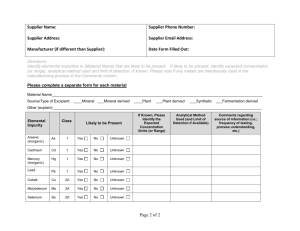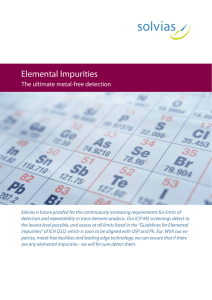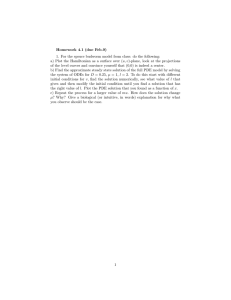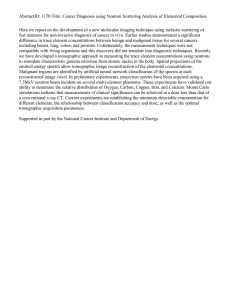ICH Training Plans-Implementation Working Group (IWG)
advertisement
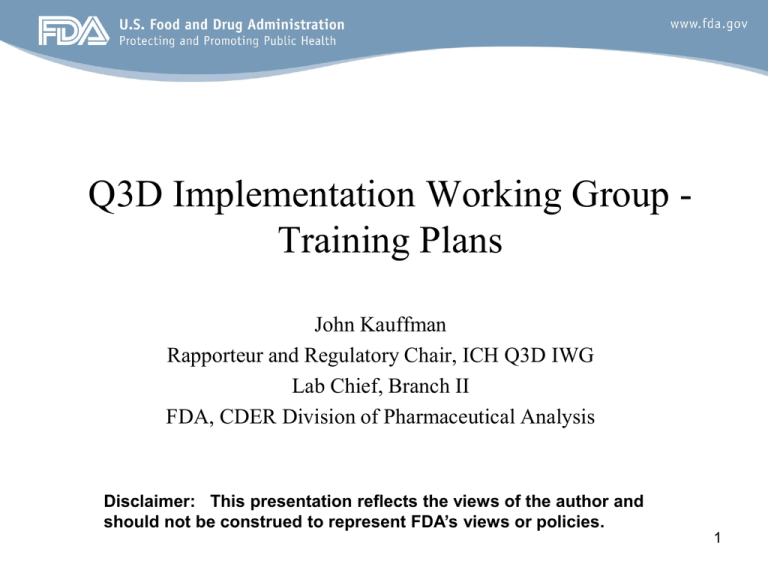
Q3D Implementation Working Group Training Plans John Kauffman Rapporteur and Regulatory Chair, ICH Q3D IWG Lab Chief, Branch II FDA, CDER Division of Pharmaceutical Analysis Disclaimer: This presentation reflects the views of the author and should not be construed to represent FDA’s views or policies. 1 Background • June 2010, ICH convened Q3D Expert Working Group (EWG) to develop harmonized limits for elemental impurities in pharmaceuticals • June 2013, ICH Q3D reached step 2 – Public comments were addressesd at June 2014 Meeting of the ICH EWG in Minneapolis, MN USA • November 2014, ICH Q3D reached step 4 – Published on the ICH Website on 16 December, 2014 2 Background • Why do we need a Q3D IWG? – Discussions of Q3D in public forums reflect a divergence of expectations for implementation. – The use of Risk Assessment is still a relatively new and potentially complex approach to pharmaceutical quality. "The potential for variability of interpretation is high." • Training material can reduce the differences in interpretation for both industry and regulatory authorities. 3 Background • October 2014, ICH approved the formation of a Q3D Implementation Working Group (IWG) • Nine (9) training modules will be prepared • Expected to be completed in Summer, 2015 • Objectives – Facilitate an aligned interpretation and harmonized implementation of Q3D – Provide detailed examples of the application of Q3D to situations that are described, but not illustrated, in the Guideline. • Training material must not expand the scope of the final guideline 4 The ICH Q3D IWG was formed in December, 2014 • Toxicologists and Chemists – High degree of homology between EWG and IWG • Six ICH Parties – EMA, EFPIA, MHLW, JPMA, FDA, PhRMA • Observers – – – – Health Canada, Swissmedic Pharmacopeias: Ph.Eur., JP, USP IPEC, WSMI, IGPA, BIO, API Industry Brazil, Chinese Taipei, Singapore 5 Overview of the Guideline • Main body, references and glossary (pages 1-17) • Appendix 1: Method for Establishing Exposure Limits (pages 18-20) • Appendix 2: Established Permitted daily exposures (PDEs) for Elemental Impurities by oral, parenteral and inhalation routes of administration • Appendix 3: Individual Safety Assessments for 24 elements (pages 23-67) • Appendix 4: Illustrative Examples (pages 68-73) 6 Workplan 1. Introduction 2. Scope 3. Safety Assessment of Potential Elemental Impurities 3.1 Principles of the Safety Assessment … Module 1 3.2 Other Routes of Administration 3.3 Justification for Elemental Impurity Levels Higher than Module 2 an Established PDE 3.4 Parenteral Products Module 4: Large Volume Parenterals 4. Element Classification 7 Workplan 5. Risk Assessment and Control of Elemental Module 5 Impurities 6. Control of Elemental Impurities Module 6 7. Converting between PDEs and Concentration Limits Module 7 8. Speciation and other Considerations 9. Analytical Procedures 10. Lifecycle Management Appendix 1: Method for Establishing Exposure Limits Module 3: Acceptable exposures for elements without a PDE Module 8: Case Studies Module 9: Frequently Asked Questions 8 Summary of Training Modules 1. How to Apply Q3D Concepts to Routes of Administration, not addressed in Q3D 2. Justification for Elemental Impurity Levels Higher than an Established PDE 3. Application of Q3D concepts to determining safe levels of elements not included in Q3D 4. Large Volume Parenterals 5. Risk Assessment 6. Control of Elemental Impurities 7. Converting between PDEs and Concentrations 8. Case Studies 9. FAQs Toxicology Chemistry 9 Consolidated Workflow Product Risk Assessment Lifecycle Change Management (e.g. new supplier, change in process, etc.) Drug product assessment approach Component assessment approach Gather information on drug product, analyze representative lots of drug product if necessary Gather information on components of the drug product, analyze representative lots of components if necessary Summarize available information, tabulate elemental impurity concentrations in the drug product Compute permissible EI concentrations using Options 3, compare with tabulated concentrations Elements that are not likely to be present (e.g., class 2B that have not been intentionally added; class 3 for solid oral; elements not identified as likely to be present in Risk Assessment) Product independent information (e.g. equipment information, container closure information) Summarize available information, tabulate elemental impurity concentrations in components of the drug product Compute permissible EI concentrations using Options 1, 2a or 2b, compare with tabulated concentrations Output of the risk assessment Elements <30% PDE (below control threshold) Elements 30-100% PDE Elements > PDE Evaluate safety assessment and rationale to support levels higher than the PDE for specific element(s) Document elements of minimal concern. No further action required Higher level justified? No Existing controls adequate Upstream Control Define Additional controls Add upstream control and evaluate impact on EI levels Specification Yes Establish specification on drug product or appropriate component of drug product Document Risk Assessment and Control Strategy 10 Consolidated Workflow 11 Consolidated Workflow 12 Consolidated Workflow Product Risk Assessment Module 5 Drug product assessment approach Component assessment approach Gather information on drug product, analyze representative lots of drug product if necessary Gather information on components of the drug product, analyze representative lots of components if necessary Summarize available information, tabulate elemental impurity concentrations in the drug product Module 7 Compute permissible EI concentrations using Options 3, compare with tabulated concentrations Elements that are not likely to be present (e.g., class 2B that have not been intentionally added; class 3 for solid oral; elements not identified as likely to be present in Risk Assessment) Product independent information (e.g. equipment information, container closure information) Summarize available information, tabulate elemental impurity concentrations in components of the drug product Compute permissible EI concentrations using Options 1, 2a or 2b, compare with tabulated concentrations Output of the risk assessment Elements <30% PDE (below control threshold) Lifecycle: Module 6 Lifecycle Change Management (e.g. new supplier, change in process, etc.) Elements 30-100% PDE Module 2 Elements > PDE Evaluate safety assessment and rationale to support levels higher than the PDE for specific element(s) Module 6 Document elements of minimal concern. No further action required Higher level justified? No Existing controls adequate Upstream Control Define Additional controls Add upstream control and evaluate impact on EI levels Specification Yes Establish specification on drug product or appropriate component of drug product Document Risk Assessment and Control Strategy 13 Frequently Asked Questions • Sources of FAQs – Public comments on Step 2b document – Constituents, referred to Q3D EWG through industry representatives – Other industry groups • FAQs include – Common questions that could not be addressed in the Guideline – Questions related to how decisions were made during development of Q3D – Examples • Why are herbal products out of scope? • How did the EWG select the 24 elements? USP and EMA have fewer elements in their documents. • Why is aluminum not included? 14 Thank you! Questions? 15
